My Tree Walk at Tuttle Park
Hey everyone! Welcome to my tree page! This Sunday, I had the chance to take a walk with a couple nice cameras (an Olympus and a Canon Rebel T6) and my field guide to identify and photography some trees. The location was at the north edge of Tuttle Park where the path meets with the Olentangy Trail. It was a nice, albeit humid, morning and my lenses were fogging up, but despite that I managed to get a few nice shots!
***Also, special note that all mentions of “the field guide” are from Peterson’s Field Guide to Trees and Shrubs by George A. Petrides. Information from the book that is stated will also include in-text citations if you want to go read yourself! All other sources used are also listed in the text. Enjoy!***
Facing my own ‘tree blindness’
As a self-professed birding fanatic, I can say I am used to knowing lots about the identification and life history nuances of our feathered species. I’ve even been leading walks to find and photograph birds because of my job at a local wild bird feeding store. But when a curious customer points at a tree? Uh oh… oh no please, PLEASE don’t ask me!
For the last few years, I have felt quite despaired because of my ‘tree blindness.’ But maybe there is hope for me… according to a piece published by Gabriel Popkin in the New York Times (2017), ‘tree blindness’ is something that can be overcome and cured..! It is my hope that with the botany classes in my major, I can overcome this gap of knowledge in my forestry and wildlife training.
In reading Popkin’s article, I appreciated that he also came from a place of only knowing a few tree species (like myself), and that he decided to tackle his blindness head on! Let’s see if during my tree walk I can do the same…
American Hackberry
(Celtis occidentalis)
The first tree on my walk is the American Hackberry. According to the field guide, American Hackberries prefer woods and open places. This makes sense because I found our tree right on the edge of a wooded area (on the very edge of a floodplain) and a neighborhood. One really cool fact about the American Hackberry that I read from the field guide is that the fruits are called “sugarberries,” and they are extremely attractive to a wide variety of gallinaceous birds. Some of these species include Northern Bobwhite, Wild Turkey, and Sharp-tailed Grouse.
In the photo below, I identified this to be an American Hackberry since it had long, tapered, and coarsely toothed leaves. It is in the Ulmaceae Family meaning it is a member of the elm family. The foliage was also smooth on the underside but somewhat rough on top. In the photo, you can also see several gumdrop-like galls forming on the undersides of the leaves. These galls were created by tiny, jumping insects called psyllids (that is fun to say!), in the genus Pachypsylla. Apparently the overwintering psyllids lay eggs on emerging leaves and the feeding young distort the leaf tissue creating ‘nipple-like’ galls (Pliesch, from the UW Madison Insect Diagnostic Lab). How cool is that?
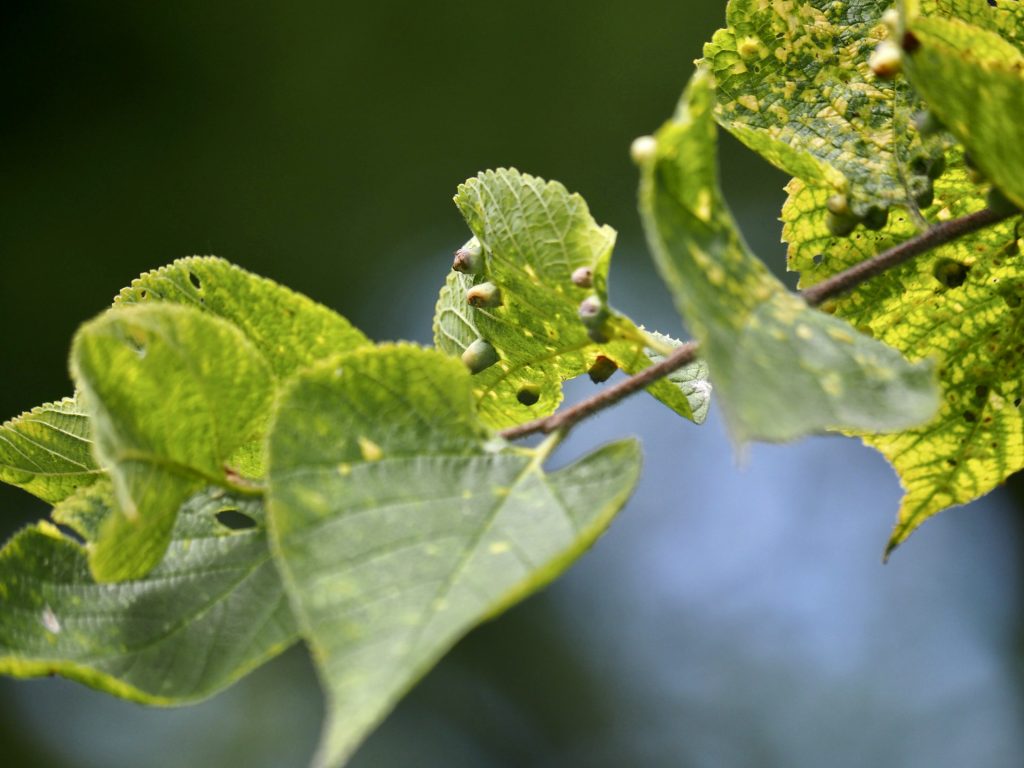
American Hackberry (Celtis occidentalis) with galls on the bottom of the leaves created by psyllid insects.
The hackberry’s bark is also quite distinctive in color and texture. It has such a strange and irregular texture that it is difficult to explain. The picture below should certainly be worth more to you than a thousand of my words. Other identifying characteristics that led me to the identification of a hackberry were its serrated leaf margins, simple complexity, and alternate arrangement.
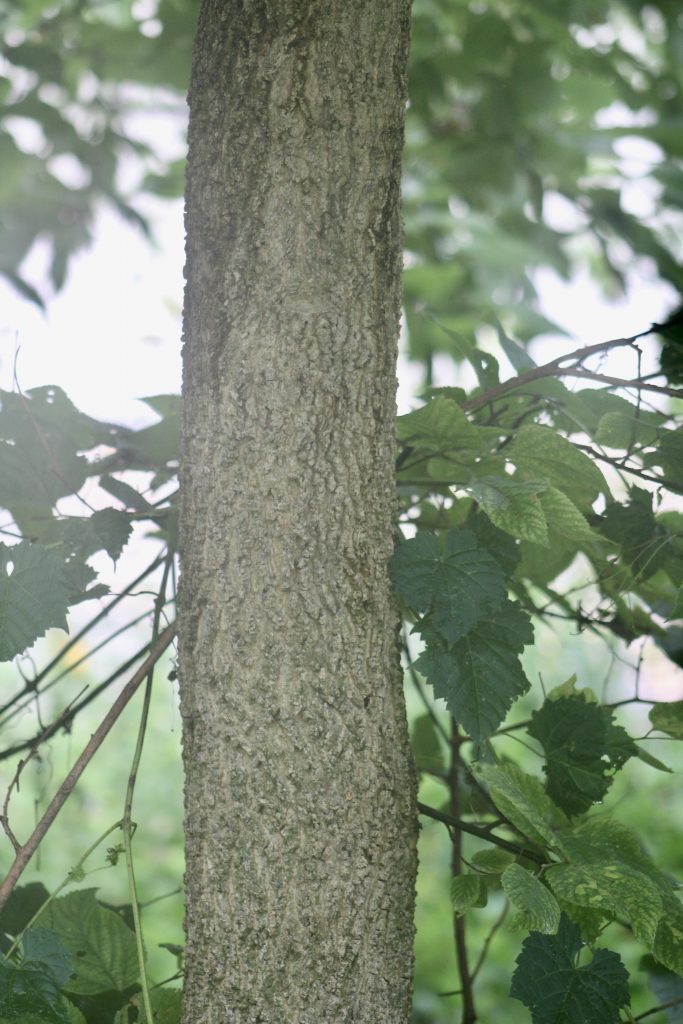
Hackberry Tree with its distinctive rough textured and dark bark
Ashleaf Maple (Box Elder)
(Acer negundo)
Now for tree #2! How interesting for a tree to have ash-like leaves, but actually be a maple, but I’ve heard most often called a Box Elder. It turns out that this tree is a bit of a special snowflake it that it has some leaves that appear to be trifoliate. It reminds me a little bit of Poison Ivy (toxicodendron radicans). “Leaves of three…”— well, I didn’t let these be, actually. This tree has oppositely arranged leaves (like most maples) that are pinnately compound with 3-5 leaflets. The leaf margin is also pretty distinct too and doesn’t really fit in a specific category. The twigs on this tree were also clearly a bright green which is also an identifier of Box Elder.
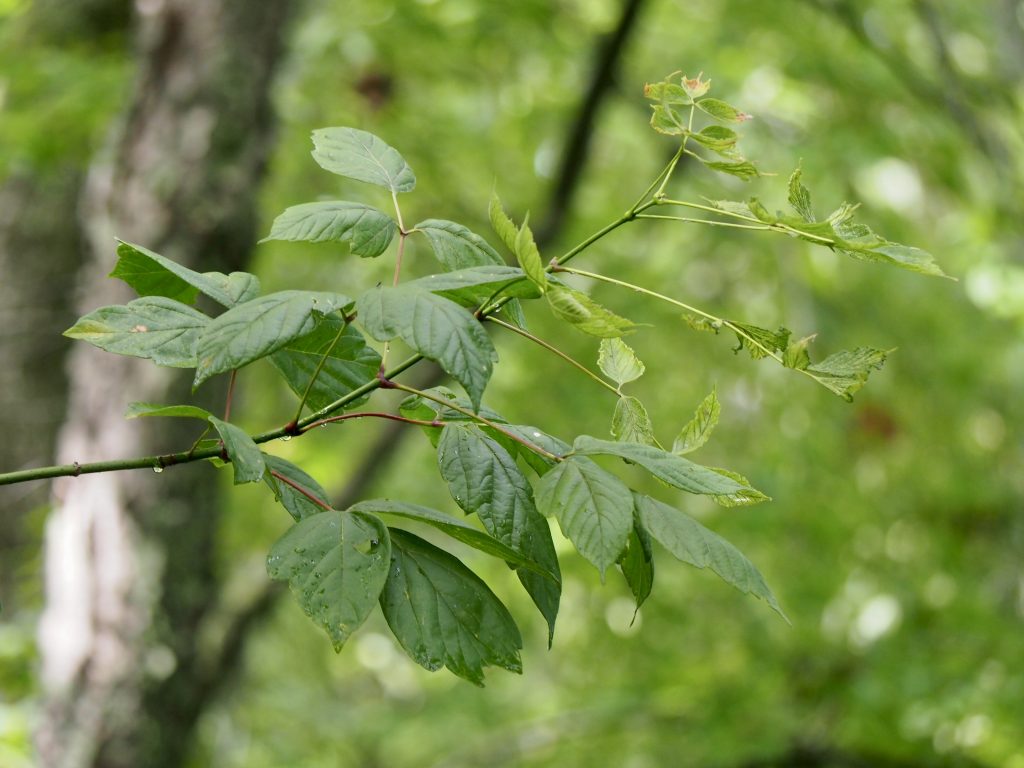
Ashleaf Maple with distinctive green twigs and trifoliate leaf complexity.
According to the field guide, Ashleaf Maples prefer riverbanks, floodplains, and fertile uplands. This tree was found in a floodplain of the Olentangy River in an area of partial shade as it was in the shadow of a few larger trees. One fun fact about this tree is that the male trees are more prized for neighborhoods and urban landscapes because they are less messy since the females have brittle and week wood (North Carolina Plant Extension, https://plants.ces.ncsu.edu/plants/acer-negundo/)
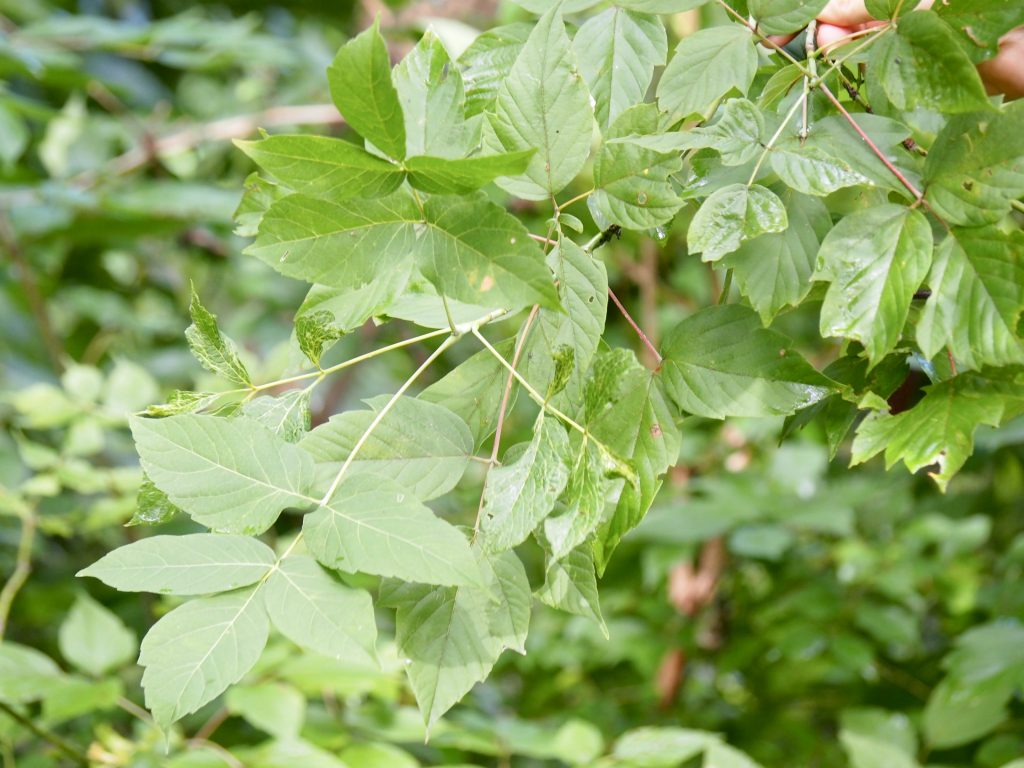
Ashleaf Maple with oppositely arranged pinnately compound leaves where some have 5 leaflets instead of the 3 trifoliate leaflets in the former photo.
Common Elderberry
(Sambucus canadensis)
For the next (third) tree, I found and identified a Common Elderberry! It says in the Petrides field guide that these plants prefer thickets. As you can see from the photo below, it was in the mix of a tangle with a few other trees. Now that’s what I call a thicket. This tree was also located within the Olentangy River floodplain on the edge of a clearing.
In addition to this tree being in a thicket, I identified this tree using leaf structure. This Common Elderberry had an opposite leaf arrangement and was also pinnately compound. The leaf margins were also serrate and the leaf-shape itself was somewhat elliptical which all gave clues to the tree’s identification.
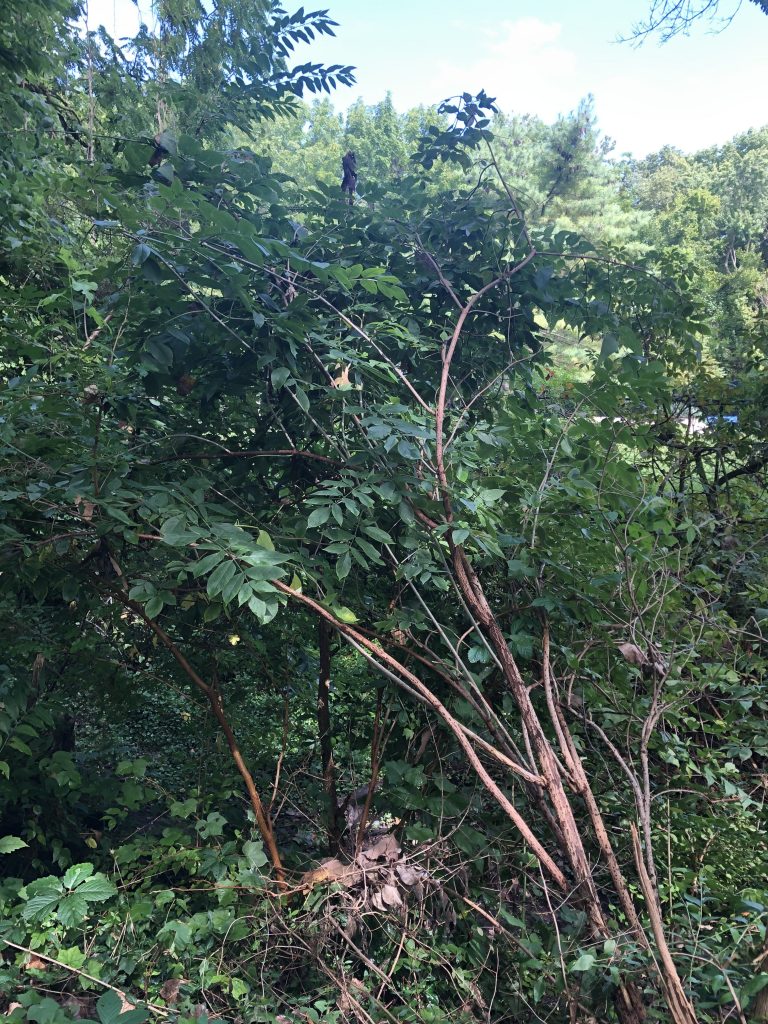
This Elderberry tree had quite the lean on it, but it still had many clear identification features.
I narrowed down this tree to a Common Elderberry, instead of a Red Elderberry, by taking a look at the flower and fruit structure. It appears that whatever fruit or flower were there have gone, but we can still see the overall flowering structure. In comparison with the Red Elderberry, the Common Elderberry’s structure is much more wide/horizontal and forms a triangle shape in comparison to the Red Elderberry which has a much more vertical, oval-shaped flowering structure (see the Peterson field guide, p. 58).
One cool fact about the Elderberry’s ecology is that many butterflies and insects are attracted the plant’s blooms. The fruit are also eaten by many mammals and songbirds. It also provides enough cover to be a great nesting site for ground-nesting birds like pheasants and quail (North Carolina Plant Extension, https://plants.ces.ncsu.edu/plants/sambucus-canadensis/).
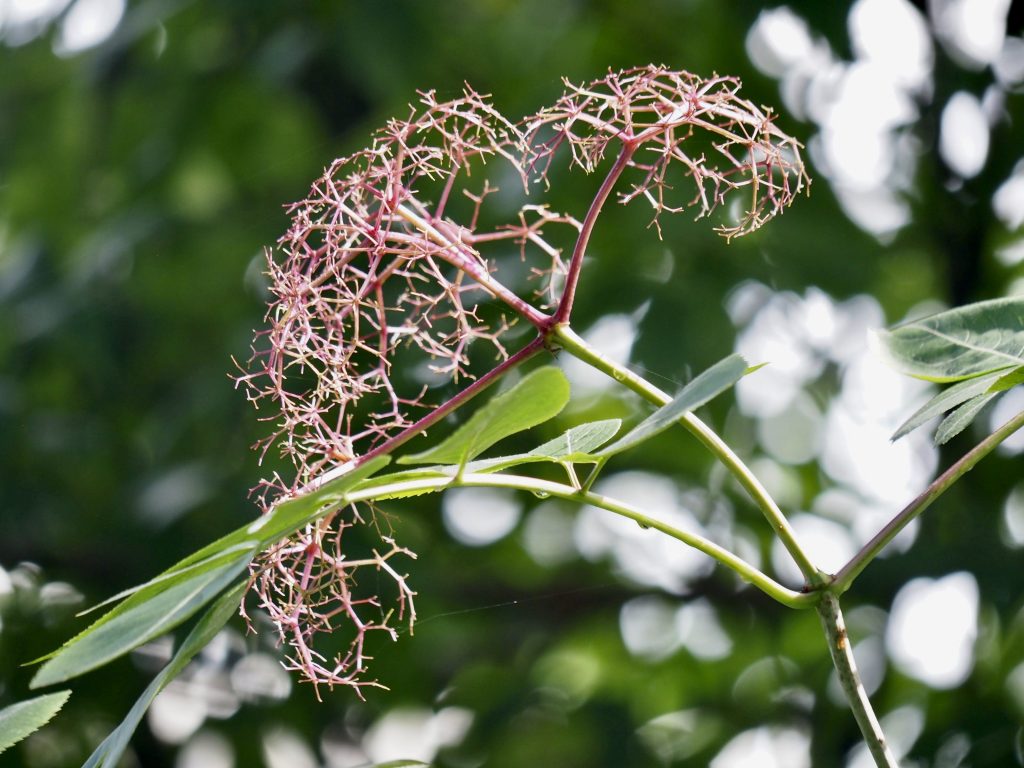
Elderberry flowering structure
Ohio Buckeye
(Aesculus glabra)
OH-IO! Even as tree blind as I am (used to be now!), I have known this tree and its scientific name for many years. Just as I have attended Ohio State for a few years now, seeing this tree was like seeing an old friend.
Buckeyes are a fan of moist wood habitat according to the field guide. This tree was found close to the trees before it, in a wooded area within the floodplain of the Olentangy River. In terms of identification characteristics, the leaves on this tree were opposite arrangement, palmately compound (with five leaflets), and had oblong leaflets with serrated margins. The tree itself was also fairly smaller in size in comparison to the walnut, sycamores, maples, and cottonwoods towering over it.
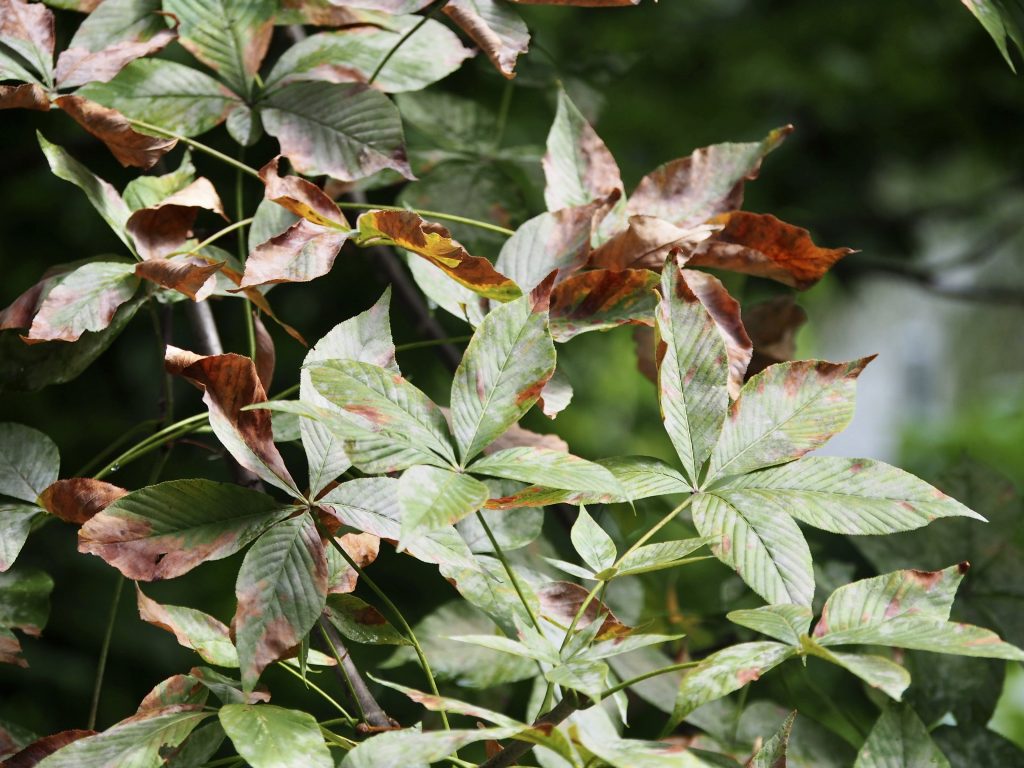
Ohio Buckeye with anthracnose disease
One interesting characteristic I noted about this tree was that it had strange blotching and discoloration on the edges of some of the leaflets. According to North Carolina Plant Extension (https://plants.ces.ncsu.edu/plants/aesculus-glabra/), this could potentially be some sort of anthracnose disease. Anthracnose is a type of fungal disease that causes lesions on the leaflets. I’ve heard of American sycamores getting this disease, but never Ohio Buckeyes! You can see how extensive the diseased leaves are in the photo below.
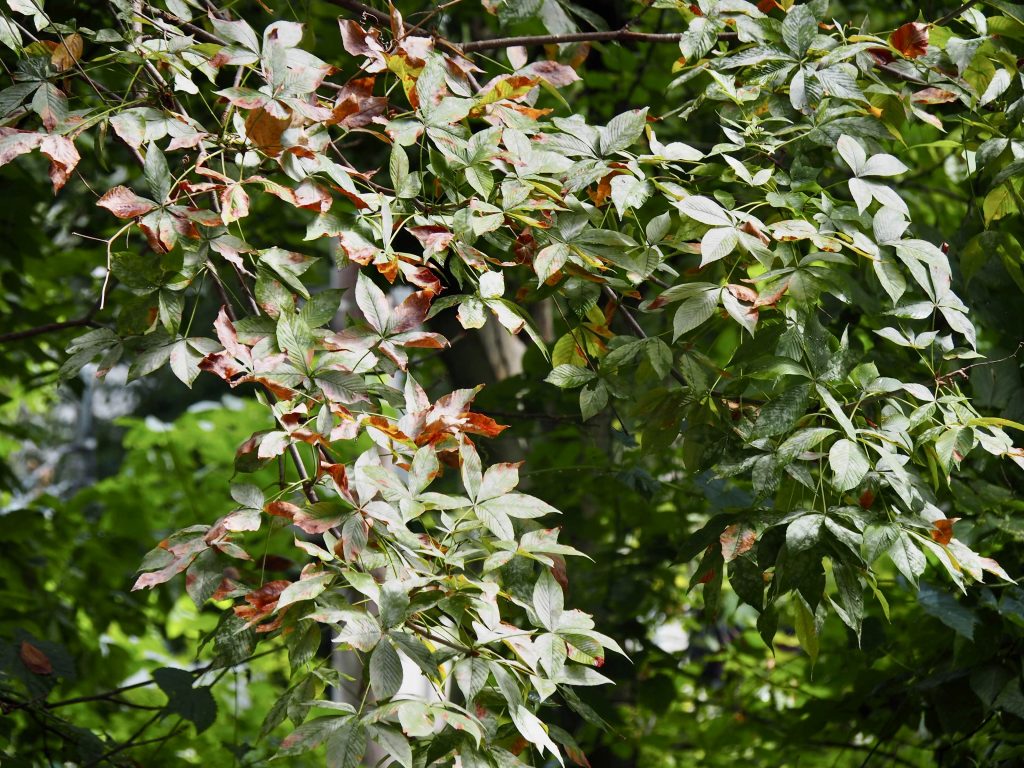
Ohio Buckeye from farther away showing a larger portion of the tree and its branches with leaves and leaflets.
American sycamore
(Platanus occidentalis)
Next on our tree walk, we discover the American sycamore. This tree has always stood out to me with its smooth, bicolored bark with tones of gray and white. It is an especially elegant tree to see contrasted against a stormy slate-blue sky. This is yet another tree that I have known throughout my lifetime and have fond memories of throughout my childhood.
This tree often finds its home in stream banks and bottomlands (according to the field guide). It explains why I saw many of these trees perched right on the edge of the bank of the Olentangy River. In fact, these trees were the most dominating figures in the reflections of the water on the river. The range of the this tree is mainly the Eastern United States, which I found interesting because of the ‘occidentalis’ part of the tree’s name means ‘west’ in Latin.
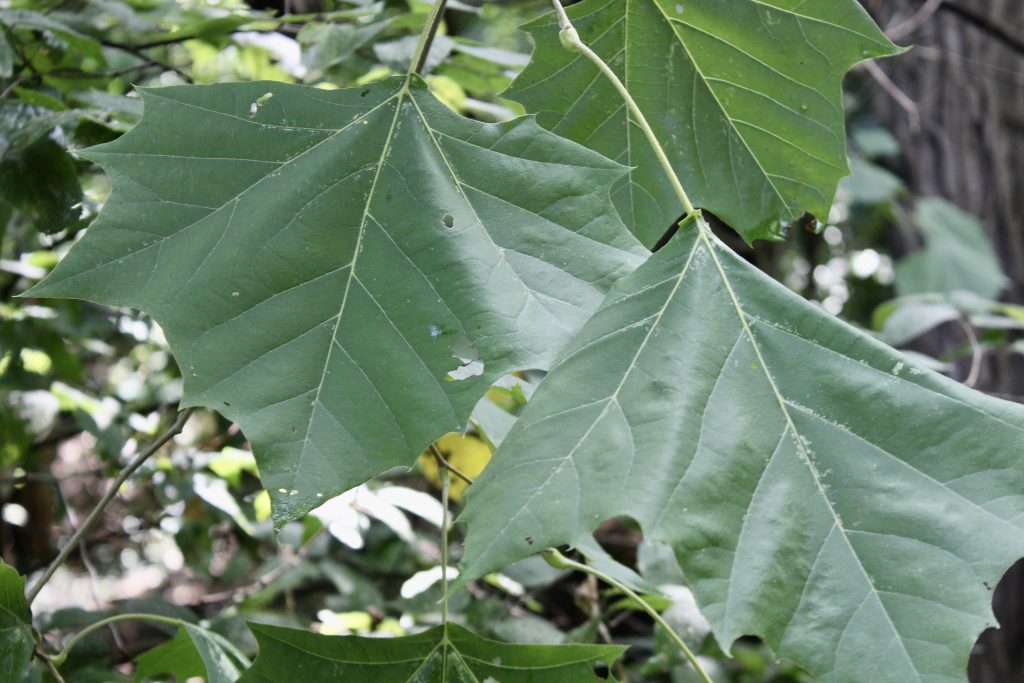
American sycamore trees close up
One ecological fact about sycamores is that as the trees age their they develop hollow trunks large enough for a number of species including the Black Bear, where their ranges overlap. Mature sycamores also provide great nesting locations for cavity nesting birds such as Great-crested Flycatchers, Wood Ducks, and Eastern Screech-owls (USDA Fire Effects Information System (FEIS), https://www.fs.fed.us/database/feis/plants/tree/plaocc/all.html)
Additional identification characteristics of this tree include that the leaf arrangement is alternate, the leaf complexity is simple, and the almost maple-looking leaves have several concave dips in them that are smooth. The stems of the leaflets are also green. Again, the bark is a dead giveaway with its gray, brown, and white pattern standing out from far away (like in the photo below).
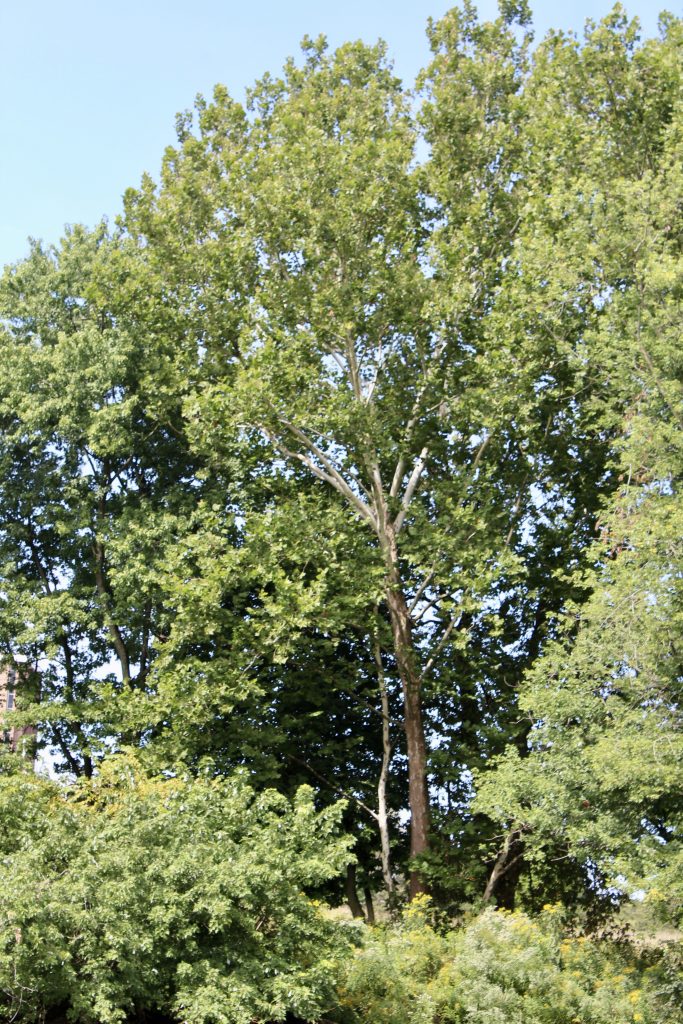
An American Sycamore tree proudly overlooking the Olentangy River
Black Walnut
(Juglans nigra)
Next on our tree walk, I encountered a Black Walnut tree! Hey! It’s one of the species we studied in class… long time no see! This tree can be identified pretty easily by its leaves. It has an alternate leaf arrangement, the leaf complexity is pinnately compound, and finally, it has many leaflets on the branch (8+). This is all indicative of it being a walnut tree. In order to narrow this down between Black Walnut and Butternut (Juglans cinerea) I took a look at the fruit. In the picture below, you can see the nut is clearly round like that of the Black Walnut while in the Butternut it is more off an oblong and tapered shape.
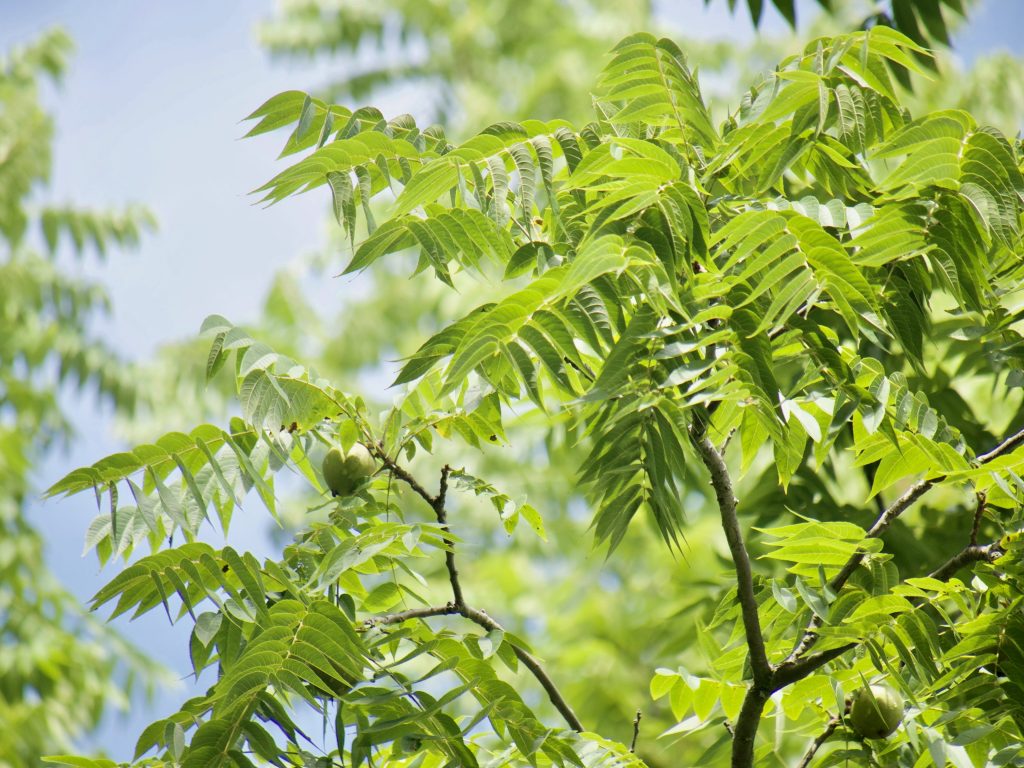
Black Walnut with spherical, green colored nuts
According to the field guide, the Black Walnut really likes wood habitats. Which is good for this walnut since it is located in one. More specifically, it is close by to Tuttle Park in the floodplain of the Olentangy River, once again. It was actually one of the tallest trees in the area and was acting as a part of the upper canopy.
One cool fact about this tree’s relation to humans is that when it is harvested as wood it is principally used as dining room and bedroom furniture. According to the FEIS (https://www.fs.fed.us/database/feis/plants/tree/jugnig/all.html), it is used as veneer for the highest grade cabinets and plywood panels (who knew!?).
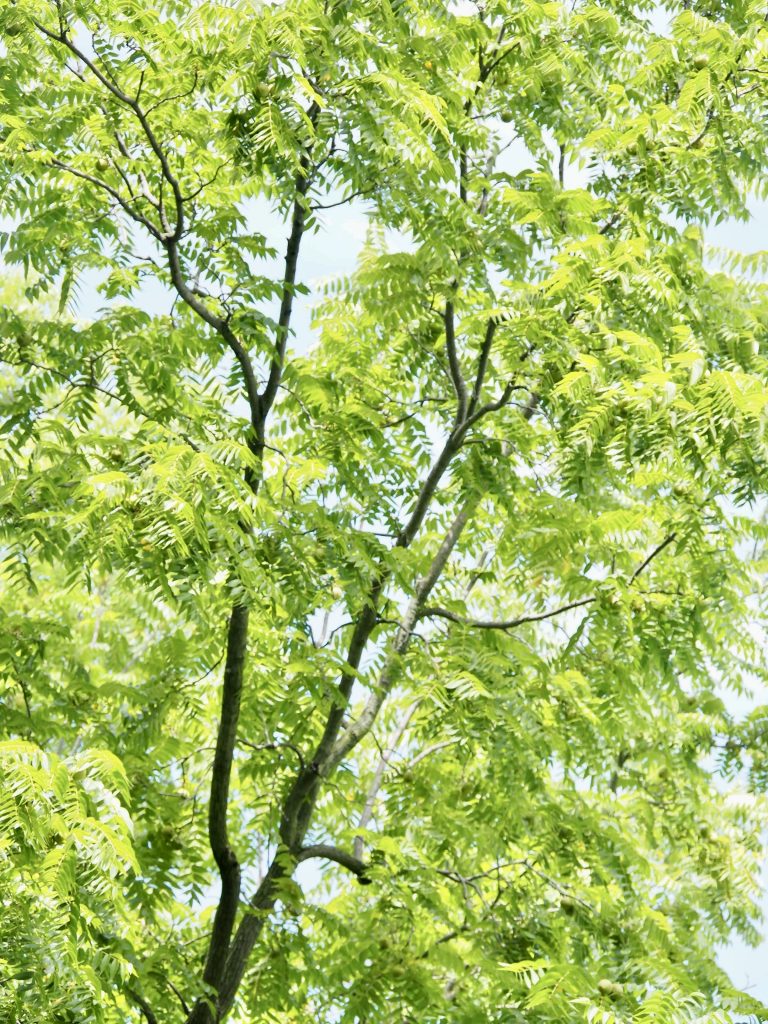
Black Walnut from farther away, in its perch at the top of the canopy
Common Spicebush
(Lindera benzoin)
Despite it being called a bush, this Common Spicebush is, in fact, a tree! Apparently it is a member of the deciduous laurel family, and prefers bottomland forests according to the field guide. This tree was found only about 50 feet from the Olentangy River, so it is close to an area that often has lots of water and flooding in the springtime. It was also part of the understory as a small tree and appeared to be receiving partial shade.
The first thing I noticed about this tree was not the leaves, for once, but the buds on it! According to the field guide, the Spicebush has buds on the stalks with two or three scales. In the photo below you can clearly see the bright green buds that are apparently present throughout winter as well. This makes the buds a great identification characteristic for all year round. The leafs are also alternate arrangement, simple complexity, and are entire with a tapered shape at the end. Finally, when crushing the leaves in my hand and sniffing it, it was quite a spicy scent!
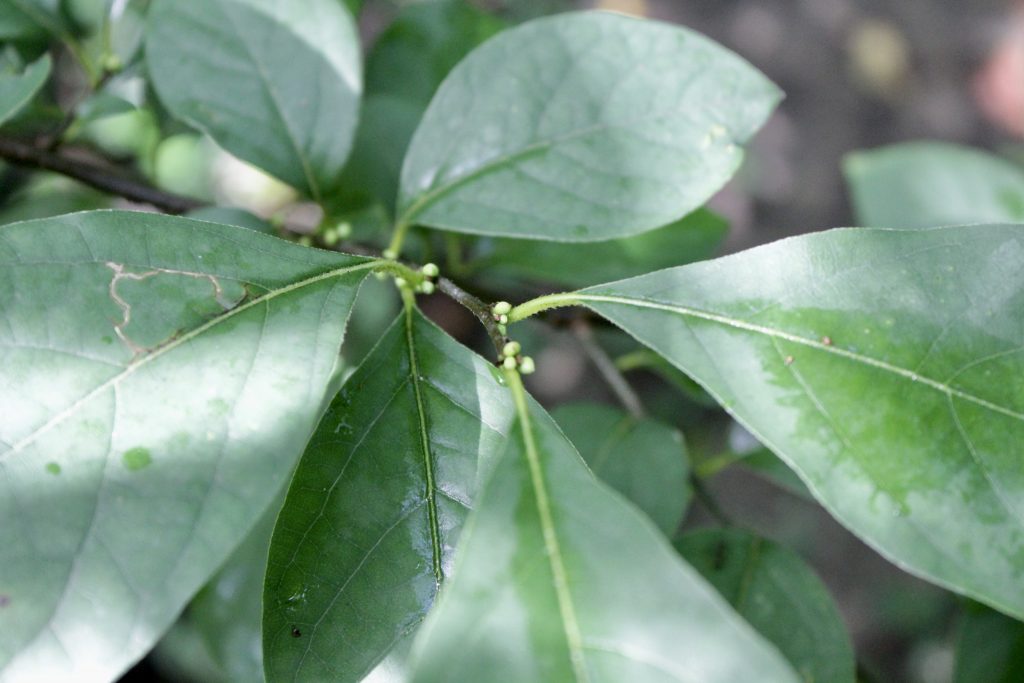
Close up look at the leaflets of the Common Spicebush. The buds
One interesting ecological fact about this tree is that it is dioecious according to Virginia Tech Dendrology (https://dendro.cnre.vt.edu/dendrology/syllabus/factsheet.cfm?ID=123). This means that the female and male reproductive organs of the trees are in separate individuals, so the trees are not hermaphroditic. Therefore, one individual would be able to only produce female gametes, while another individual would be able to produce male gametes.
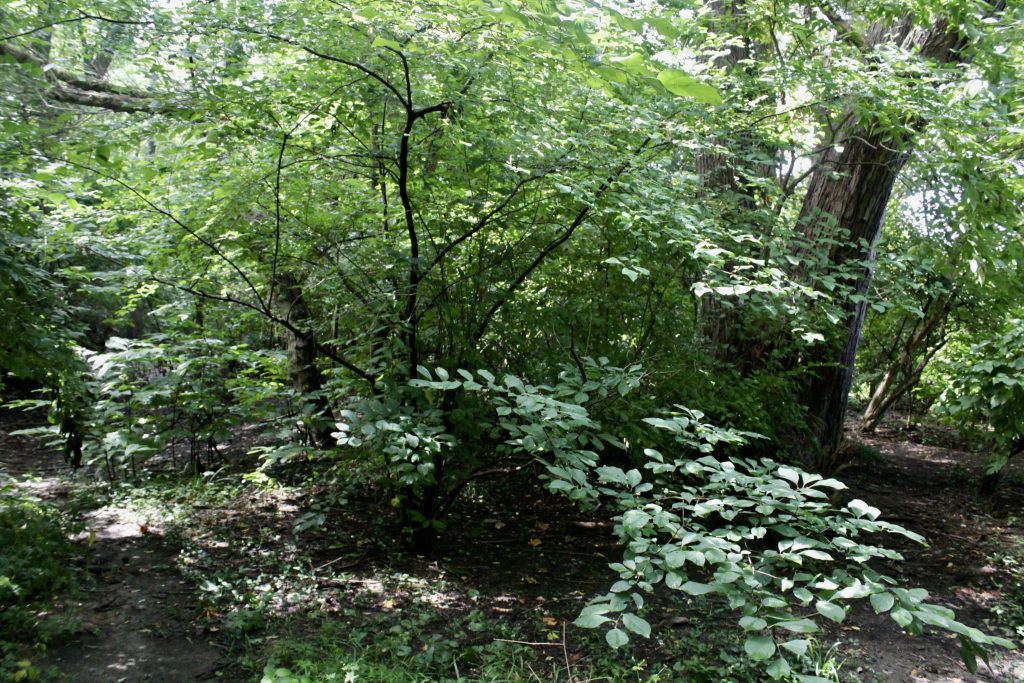
A gorgeous Common Spicebush specimen. I love this tree.
Common (Eastern) Cottonwood
(Populus deltoides)
Last, but certainly not least, is the Common Cottonwood. This species, according to the field guide, loves rich soils. I found it within the floodplain of the Olentangy River as one of tallest trees in the woodland (in the upper canopy). Cottonwoods also love to grow in areas of high moisture which means they like to grow on the sides of streams, swamps, and ponds according to Gardenerdy (https://gardenerdy.com/factors-to-remember-for-cottonwood-tree-identification/). The trees also I saw were often right along the riverbank.
I was able to identify this tree from far away, because even in the light wind, the leaves were incessantly waving in the breeze making the tree appear almost anxious. Cottonwood tree leaflets have flat stalks which make them more vulnerable to blowing in the wind compared to other deciduous trees with round stalks. The leaves themselves were also an odd triangular shape. The species name “deltoides” in Latin refers to a ‘delta’ which means triangle and the ‘-oid’ part refers to it being ‘like a triangle’ which refers to the leaf shape. The leaf margin is somewhat serrate, the leaf complexity is simple, and the leaf arrangement is alternate.
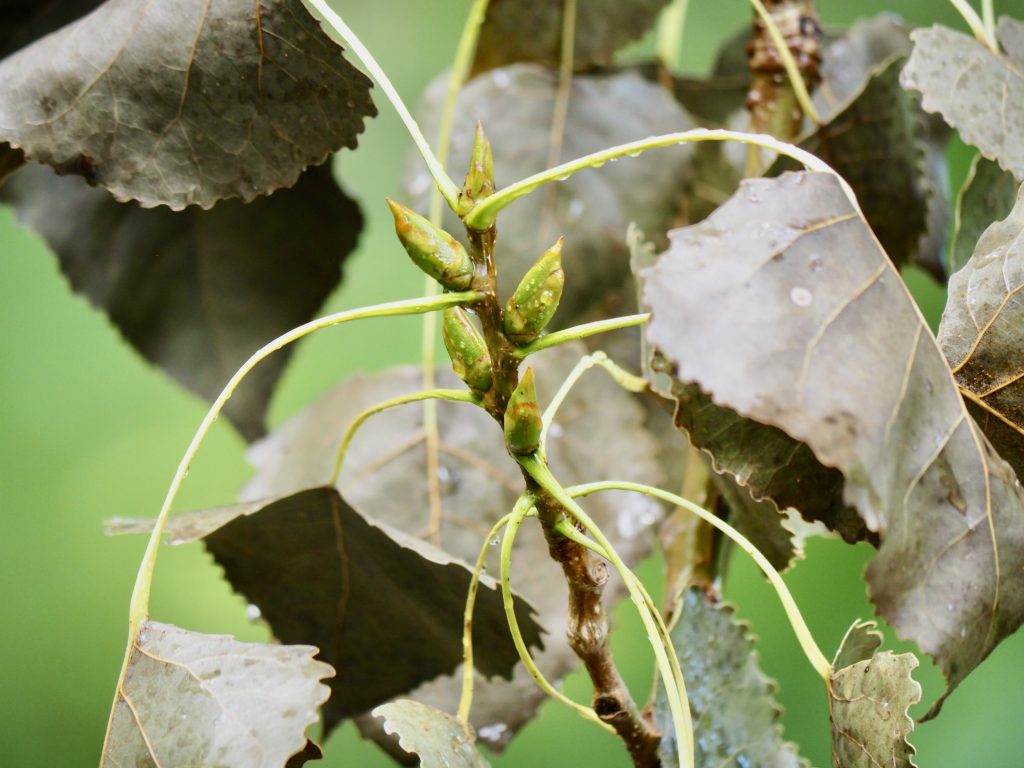
Common Cottonwood sticky buds found on a fallen branch.
The buds above can also be used to identify the cottonwood. To the touch, they were quite sticky and a bright green! I got a chance to touch the buds because this branch from a cottonwood had fallen onto the trail. As you can see, the leaves had already started to turn a brown color.
One interesting ecological fact about the cottonwood is that it is a truly global group of trees! Various species of cottonwood can be found across North America, Europe, and even some regions of Asia (Gardenerdy).
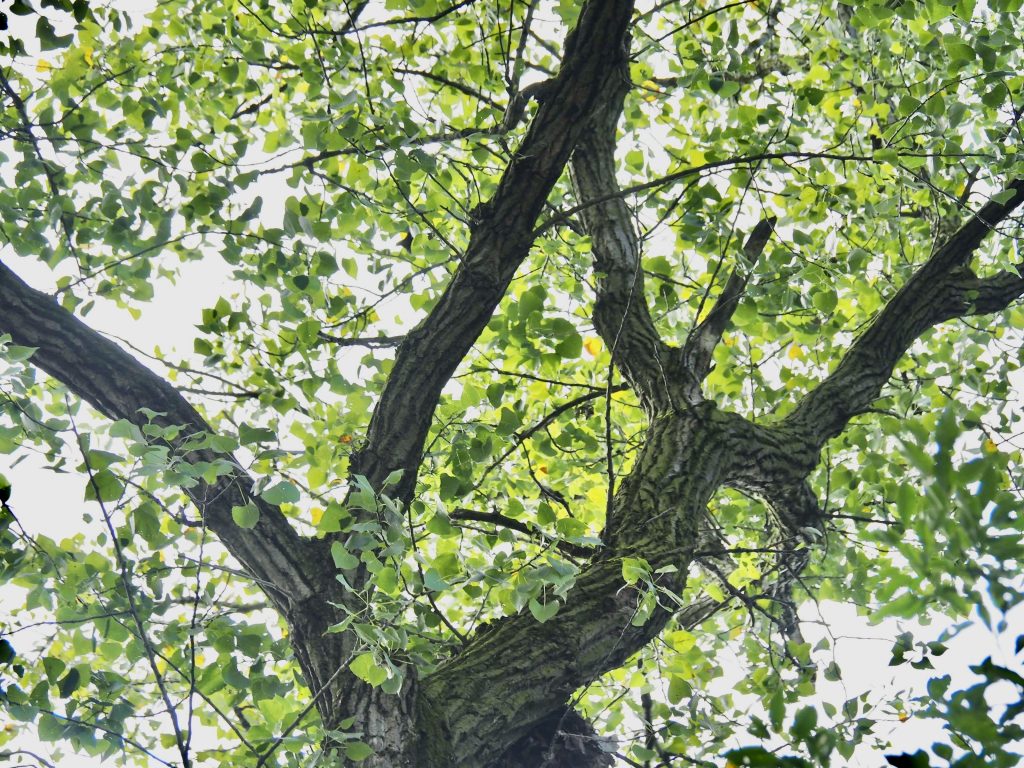
Cottonwood canopy from below.
With the last tree species, our tree walk has drawn to a close. Like Gabriel Popkin, I was able to take the first step in curing my tree blindness. In just a short walk I have already learned so much. As Popkin states in his article “when you engage with a tree, you momentarily leave the human-created world,” I also stepped out of my anthropocentric focus to have a better idea of the wild things growing around me. Not only do trees allow us to leave our ‘human space,’ but they also allow us to experience the health of the ecosystem and give us a clue of the management of the habitat we are in. Popkin agrees with this thought when he speaks of fire regime and species composition management. A truly insightful experience, and I am excited for more!
Here is the link to read Gabriel Popkin’s Article on Tree Blindness, a source of comparison and inspiration for my article: https://ohioplants.org/tree-blindness/
